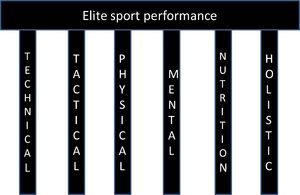The six pillars of sports performance
| Course dashboard for (#oeruesp) | |
|---|---|
| Introduction & context evaluation | Introduction & Aims | Video signpost - Searching the DOAJ | E-Activity 2.1 - Annotated bibliography | Video signpost - Six pillars and psychological challenges | The six pillars | Psychological challenges | E-Activity 2.2 - Context evaluation | FAQs |

Introduction
Lorem ipsum dolor sit amet, consectetur adipiscing elit. Vivamus molestie pellentesque nisl, ac venenatis velit accumsan nec. Suspendisse iaculis aliquam lobortis. Vestibulum vitae ultricies ante. Nunc tellus felis, egestas in est bibendum, ornare dignissim est. Sed vel nulla pellentesque, interdum mauris vitae, ornare nisi. Morbi id odio vitae erat dictum cursus. Nam rutrum sagittis risus faucibus pellentesque. Donec mollis sem in odio egestas, et consequat libero blandit. Proin non quam et leo posuere elementum sed id augue. Praesent vestibulum faucibus sodales. Praesent ultricies sit amet purus a molestie. Aliquam vitae felis nec lorem rutrum scelerisque sit amet sed diam. Nullam feugiat arcu magna, ac feugiat tellus tincidunt sed. Phasellus malesuada, nulla sit amet posuere sodales, velit ipsum lacinia tortor, nec luctus mauris libero et nisi. Vivamus sapien libero, sollicitudin eget pellentesque at, blandit ac lectus. Vestibulum ante ipsum primis in faucibus orci luctus et ultrices posuere cubilia Curae;
The Six Pillars of Sports Performance
- Technical – this performance pillar refers to the fundamental and more advanced skills of the sport. In soccer, for example, these would include passing, receiving, dribbling, shooting, heading, tackling, throw-ins, penalty-taking, goalkeeping, and so on.
- Tactical – this performance pillar refers to strategies and decision-making. In soccer, it would include formations (4-2-3-1, 4-4-2, 4-3-3, etc.), decisions about zonal or man marking, pressing and offside strategies, triangular movement, counter attacking, set piece plays, and so forth.
- Physical – this performance pillar refers to the strength and conditioning aspects of elite performance, such as aerobic and anaerobic fitness, strength, speed, power, flexibility, agility, balance, etc.
- Mental – the mental pillar is the one addressed in this micro-course. It refers to a wide range of psychological variables that influence performance and are influenced by it. The typical list of mental skills associated with elite athletes includes positive attitudes, mental imagery and self-talk, high self-motivation and self-confidence, good concentration, and effective management of emotions and moods. In team sports, effective leadership and group cohesion are especially important.
- Nutrition – this performance pillar refers to such things as general diet, nutrition specific to training and competition, assessment of body composition, hydration strategies, and use of legal supplements.
- Holistic – this pillar concerns factors such as career planning and development, financial management, insurance, personal organisation and leadership. An elite athlete’s playing career may be short and so many sport organisations acknowledge that they have a responsibility to support holistic development and thereby assist players to prepare for a life after sport.
(![]() : Think about a microblog activity to include here. --Mackiwg 00:28, 16 August 2013 (UTC))
: Think about a microblog activity to include here. --Mackiwg 00:28, 16 August 2013 (UTC))
